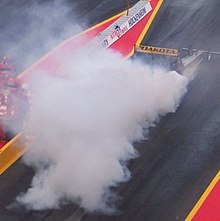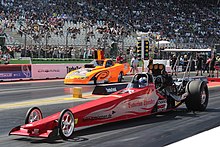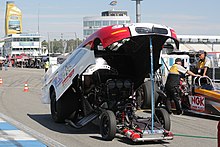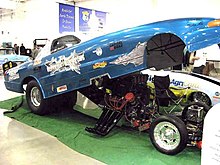Dragster
Dragsters are vehicles that have been specially designed or modified for drag racing (acceleration races). Dragsters are driven by large-volume, mostly charged motors with up to a few thousand HP or kW of power, which are brought to the drag strip via very wide drive wheels . In the narrower sense, only racing cars are referred to as dragsters, while motorcycles are referred to as drag bikes . The classic race distance is a quarter mile, which corresponds to 402.34 meters.
technology
Dragsters have their origins in the USA . The FIA rules applicable in Europe for the professional classes were largely adopted by the US NHRA . In the professional classes, only stick block engines , conventional eight-cylinder OHV engines with an underneath camshaft and two valves per cylinder, such as those installed in American sports cars or muscle cars in the 1960s and 1970s, are permitted . Turbocharged engines have a displacement of around 8 liters, and naturally aspirated engines sometimes more than 14 liters. Compared to modern racing engines, the engines have a relatively long stroke. As a result, they deliver high torque even at low speeds; the maximum speed is around 8000 to 9000 revolutions per minute. The enormous performance is mainly achieved by charging with mechanical chargers and by using special fuels such as methanol or nitromethane .
Amateur classes
Super Comp
The vehicles of the Super Comp class are specially designed for drag racing. Any car engine is permitted as a drive, turbochargers and Roots-type compressors can be used for supercharging. The engines can be operated with gasoline, gasoline-alcohol mixtures, methanol or nitrous oxide. The minimum weight of the racing car depends on the class and the number of cylinders. The higher the class, the lower the minimum weight, the higher the number of cylinders, the higher the minimum weight. A time index of 8.90 s for the quarter mile is specified for this class.
Competition Eliminator
The highest amateur class is Competition Eliminator. All types of vehicles are permitted, both dragsters with a long wheelbase as well as roadsters or door slammers, vehicles with functional doors. The dragsters with their long wheelbase are similar to the dragsters of the professional teams, while the so-called Altereds come up with a specially made or heavily modified body. The minimum weight of the dragster is 612 kg for V8 engines, 454 kg for 6-cylinder engines and 386 kg for 4-cylinder engines. The minimum weights of the altereds are a few hundred kilograms higher. A typical engine is a turbocharged V8 engine with a displacement of 4.6 l. The most powerful vehicles produce up to 1500 hp. Due to the comparatively low weight, quarter mile times of less than seven seconds are possible in this class, with speeds of over 300 km / h being achieved.
Professional classes
Per floor
The Pro Stock (PRO) class is reserved for two-door coupes whose body shape is based on vehicles that are no more than 15 years old from series production. These are pure racing vehicles on a tubular space frame, but the doors must be functional as in the corresponding series vehicle. In the Pro-Stock class, the body shape and petrol engine must come from the same manufacturer; conventional eight-cylinder OHV naturally aspirated engines with an underneath camshaft and two valves per cylinder are permitted. So special fuels or charges are not allowed. The maximum displacement is 500 cui (8193 cm³), the minimum weight is 1,066 kg including the driver. According to the rules of the IHRA in the USA, up to 800 cui or over 13 liters of displacement are permitted. At speeds of around 8,000 rpm, the engines deliver up to 1,400 hp and enable quarter-mile times under 7 seconds at top speeds of over 320 km / h.
Pro Modified
The Pro Mod (PM) class represents the fastest and most spectacular class of vehicles with functional doors ( Doorslammer ). The name for the class was only coined in the early 1990s, but the body shapes are based in part on vehicles from the 1930s or on Pick-up trucks. In addition, older pro-stock racing cars are being upgraded, for example if their approval expires or an even more powerful vehicle is to be built. Extensive modifications to the body such as lowering the roof, lengthening or widening and spoilers are permitted. The underlying original must, however, remain recognizable. In conjunction with imaginative paintwork, this creates spectacular racing cars that also have enormous performance. When using naturally aspirated engines, a maximum displacement of 14,748 cm³ (900 cui ) and nitrous oxide injection are permitted. The minimum weight is 1,065.9 kg (minus 11.3 kg for vehicle models older than 1959, plus 11.3 kg for vehicle models younger than 2000). If a compressor- charged methanol engine is used, which can be recognized by the air inlet protruding from the bonnet, the displacement is limited to 8,636 cm³ (527 cui ). When using turbocharging, the maximum displacement is 10,651.5 cm³ (650 cui ). The minimum weight for charged vehicles is 1,224.4 kg. In any case, the engines must be of traditional American design, V8 with a camshaft below and two valves per cylinder. The engines used in the Pro Mod class have an output of over 2,500 hp. On the quarter mile, top speeds of over 350 km / h are reached after a good 6 seconds.
Top Methanol Funny Car
The chassis of the top methanol class, the second highest class, are custom-made from tubular space. Top Methanol Funny Cars (TMFC) are racing cars with normal length and attached plastic bodies, the design of which is mostly based on the American sports car. The engines run on methanol and generate around 2,500 to 3,000 hp. The maximum permissible displacement and the minimum weight depend on the type of compressor used and are 9,258.7 cm³ (565 cui ) or 998 kg for vehicles with Roots-type compressor and 8,652.3 cm³ (528 cui ) or 1,043.3 kg for vehicles with screw compressor.
Top methanol dragster
Vehicles with a long wheelbase are known as Top Methanol Dragsters (TMD). The displacement of dragsters without a compressor is limited to 7,472.5 cm³ (456 cui ), the minimum weight to 963.6 kg. However, these racing cars can run on nitromethane. For vehicles with a Roots compressor , the displacement is limited to 8,652.3 cm³ (528 cui ) and the minimum weight to 895.6 kg. For vehicles with a screw compressor, the values are 7,636.3 cm³ (466 cui ) or 929.6 kg. Turbocharged engines must run on methanol. Only conventional eight-cylinder OHV four-stroke engines with an underneath camshaft and two valves per cylinder are used as drive , the design of which is mostly based on that of the Chrysler Hemi engine . With the permitted modifications, the V8 engines produce 2500 to 3500 hp. Top Methanol Funny Cars and Dragsters cover the quarter mile in less than six seconds and reach speeds of 350 to 400 km / h when crossing the finish line.
Top Fuel Funny Car
The undisputed premier class are the vehicles of the Top Fuel class, here too, the Funny Cars (FC) and Top Fuel Dragster (TF) categories are competing. The chassis are custom-made from tubular space. Funny Cars and Top Fuel Dragsters differ in principle only in the construction of the chassis and the shape of the body. Funny Cars are normal length, the engine is in front of the driver. The design of the attached plastic body is mostly based on the American sports car. Funny cars have a particularly critical driving behavior due to their short wheelbase. As with the Top Fuel Dragsters, only stick-block engines with a displacement of 8,193.5 cm³ (500 cui ) are used as engines . The technical specifications as well as the performance data are the same. Due to the slightly higher vehicle weight, the times of the Funny Cars are slightly higher than those of the Top Fuel Dragster.
Top fuel dragster

The chassis of the Top Fuel Dragster (TF) are custom-made from tubular space with a wheelbase of around 7.60 m. After dragsters rolled over backwards at high speeds several times, the wheelie bar on the rear of the vehicle, which is already common in the other classes, was prescribed.
The engines are operated with a mixture of 85–90% nitromethane and 15–10% methanol . The displacement is limited to 8,193.5 cm³ (500 cui ). Only stick block engines , conventional eight-cylinder OHV four-stroke engines with an underneath camshaft and two valves per cylinder are used. Most of the teams use the aluminum replica of the proven 426 Chrysler Hemi engine from the 1960s. In contrast to the series counterpart, however, the engine block has no channels for cooling liquid, since the evaporative cooling of the fuel is sufficient for cooling during the short operating time. This also increases the strength of the engine block. Cylinder heads, connecting rods and the crankshaft are special parts made from high-strength materials. The very light titanium is also used to keep the weight of the oscillating masses, such as the connecting rods, as low as possible . Two or three spark plugs per cylinder are supplied with voltage by a high-performance ignition system. The engine dies already halfway through the run, which means that the mixture ignites by itself at the extremely hot exhaust valves. The engines are operated close to the mechanical load limit, after each run the engine is completely dismantled and examined. Defective parts such as bearings, connecting rods or pistons are replaced. The compressor compresses more than 1 m³ of air per second and presses the intake air into the combustion chambers with an overpressure of up to 5 bar . The nitromethane is not gasified, but rather injected into the combustion chambers in liquid form. At full throttle , the engines are operated close to the hydraulic lock. The ratio of nitromethane to intake air is used to adjust the output so that the wheels do not just spin.
Records
The fastest times are achieved with Top Fuel Dragsters, the Top Fuel Funny Cars are about two tenths longer on the road. In terms of top speeds, however, the Funny Cars have been ahead for several years. Records are only possible under favorable external conditions, as temperature, humidity or air pressure have a significant impact on the performance of the engines and the track temperature influences the grip of the tires. A time is only recognized as a record if it is confirmed in the same event with another time, which may have a maximum deviation of 1%.
- Quarter mile
On November 12, 2006, NHRA driver Tony Schumacher improved the ET record over the quarter mile at the Auto Club Raceway in Pomona to 4.428 s and reached a top speed of 527.83 km / h. In addition, Tony Schumacher set the speed record over the quarter mile on August 13, 2005 at the Brainerd International Raceway with his Top Fuel Dragster. It reached 337.58 mph (543.28 km / h) after a time of 4.446 s.
The US International Hot Rod Association (IHRA) records are a little slower. The records in Australia are partly held by Americans. In Europe, Europeans achieved the best performances with 4.572 seconds (Andy Carter, Santa Pod , September 2010) and 510.26 km / h (Risto Poutiainen, Santa Pod, May 2011).
European teams are also successful in the USA despite only a few starts. The Swede Jonnie Lindberg lowered the NHRA record for Top Alcohol Funny Cars on March 29, 2015 in Concord, North Carolina to 5,361 s. His brother Johan won his first NHRA trophy in 2017.
The European bests (FIA) on the no longer driven quarter mile are held by the Brit Andy Carter with 4,572 seconds (Sept 2010 / Santa Pod / UK) and the Finn Risto Poutiainen with 510.26 km / h (May 2011 / Santa Pod / UK )
- A thousand feet
After Scott Kalitta's fatal accident in 2008, the NHRA shortened the race distance of the top fuel classes to 1,000 feet to reduce engine and tire damage and to have a slightly longer run-off distance. The ET record was improved to 3.701 s on October 8, 2012 by Antron Brown. Spencer Massey reached a record top speed of 332.75 mph (535.51 km / h) with a Top Fuel Dragster on August 23, 2015. On September 17, 2011, a Top Fuel Funny Car beat the four-second mark for the first time.
With Brittany Force and Leah Pritchett, two women took the top fuel records from 2016 and improved them in spring 2017, Pritchett 3,658 s, Force 333.66 mph. Matt Hagan set two new records in one run in Topeka on May 20, 2017 Funny Cars, 3,802 s and 338.85 mph (545.33 km / h). In doing so, he also exceeded the speed record set in 2005 on the quarter mile.
The European bests over 1000 ft are currently (as of September 2019) held by the Norwegian TF dragster pilot Maja Udtian with 3: 806 seconds, achieved in Santa Pod (GBR) in September 2019. The Swiss Jndia Erbacher achieved in August 2019 in Tierp (SWE) the highest top speed so far with 513.31 km / h (318.96 mph).
- Eighth mile
IHRA also holds top fuel races on 1/8 mile routes. The best values are 3.106 s and 275.22 mph (442.9 km / h).
Jet dragster
Jet dragsters powered by jet engines from discarded fighter jets or gas turbines from helicopters are often shown for show purposes . The conversion of the thrust into performance of 10,000 or 20,000 HP is not very meaningful when the start is standing still. Jet dragsters do not fit into any motorsport class and are not regulated by the FIA . Also for safety reasons there are no races with them. The times achieved in the show runs are in some cases significantly behind those of the Top Fuel Dragster.
See also
Web links
- General provisions of the DMSB for dragsters (PDF; 1.0 MB)
- FIA
- DMSB
- NHRA
- German Drag Racing History (information about the German drag racing scene)
- The website of the only German Pro Stock Team
- Information about classic Dragster on beetle basis (Engl.)
- Drag Racing News
Individual evidence
- ↑ Golden Vette Drag Race Team Switzerland [1]
- ↑ No WAY! Tony Schumacher Takes it All. fastmachines.com, November 12, 2006, archived from the original on March 23, 2007 ; accessed on June 14, 2011 .
- ↑ Schumacher, Medlen, Warren Johnson and Tonglet are Qualifying Leaders. dragracecentral.com, August 25, 2005, accessed June 12, 2011 .
- ↑ Archive link ( Memento from June 22, 2011 in the Internet Archive ) TOP FUEL DRAGSTER CLAY MILLICAN ROCKINGHAM Oct-05 4,484 - TOP FUEL DRAGSTER CLAY MILLICAN BUDDS CREEK Sep-07 328.14
- ↑ Page no longer available , search in web archives:
- ↑ http://www.eurodragster.com/timing/europeanbests/europe_2011.htm
- ↑ http://www.eurodragster.com/timing/europeanbests/2019.htm
- ↑ Archive link ( Memento from June 16, 2011 in the Internet Archive )
- ↑ Archive link ( Memento from May 29, 2016 in the Internet Archive )
- ↑ FC 3995 17/09/11 Matt Hagan - Christiansburg, VA Concord, NC
- ↑ http://www.eurodragster.com/timing/europeanbests/2019.htm
- ↑ Archive link ( Memento from June 22, 2011 in the Internet Archive ) TOP FUEL DRAGSTER TERRY MCMILLEN TORONTO Sep-07 3.106 - TOP FUEL DRAGSTER TJ ZIZZO TORONTO Sep-07 275.22









